Weekly Arizona COVID-19 Data Report – Dr. Joe Gerald, March 19 Update
Note this forecast page is not the most recent forecast available.
Researcher Analyzes Arizona COVID-19 Spread Models for Decision-Makers
The following information regarding the spread of COVID-19 in Arizona was prepared by Joe Gerald, MD, PhD, a researcher at the Mel and Enid Zuckerman College of Public Health (MEZCOPH) at the University of Arizona. This information has also been reviewed by other MEZCOPH faculty.
This data were obtained from the Arizona Department of Health Services COVID-19 webpage and reflect conditions in Arizona as of March 19, 2021.
This information is intended to help guide our response to the outbreak. It is not intended to predict how this pandemic will evolve. Rather, this model extrapolates what might occur if current conditions remain unchanged. As regional authorities and healthcare providers respond, their actions are expected to mitigate the worst consequences of this pandemic.

COVID-19 Disease Outbreak Forecast
Arizona State and Pima County
Updated March 19, 2021
Disclaimer: This information represents my personal views and not those of The University of Arizona, the Zuckerman College of Public Health, or any other government entity. Any opinions, forecasts, or recommendations should be considered in conjunction with other corroborating and conflicting data. Updates can be accessed at https://publichealth.arizona.edu/news/2021/covid-19-forecast-model.
For the week ending March 14th, 4445 Covid-19 cases were diagnosed in Arizona (Figure 1). This represents a 22% decrease from last week’s initial tally of 5721 cases and marks the ninth straight week of decline. The prior week’s tally was downwardly revised by 1% (54 cases) to 5667 cases this week. The outbreak remains evenly distributed by age (Figure 2).
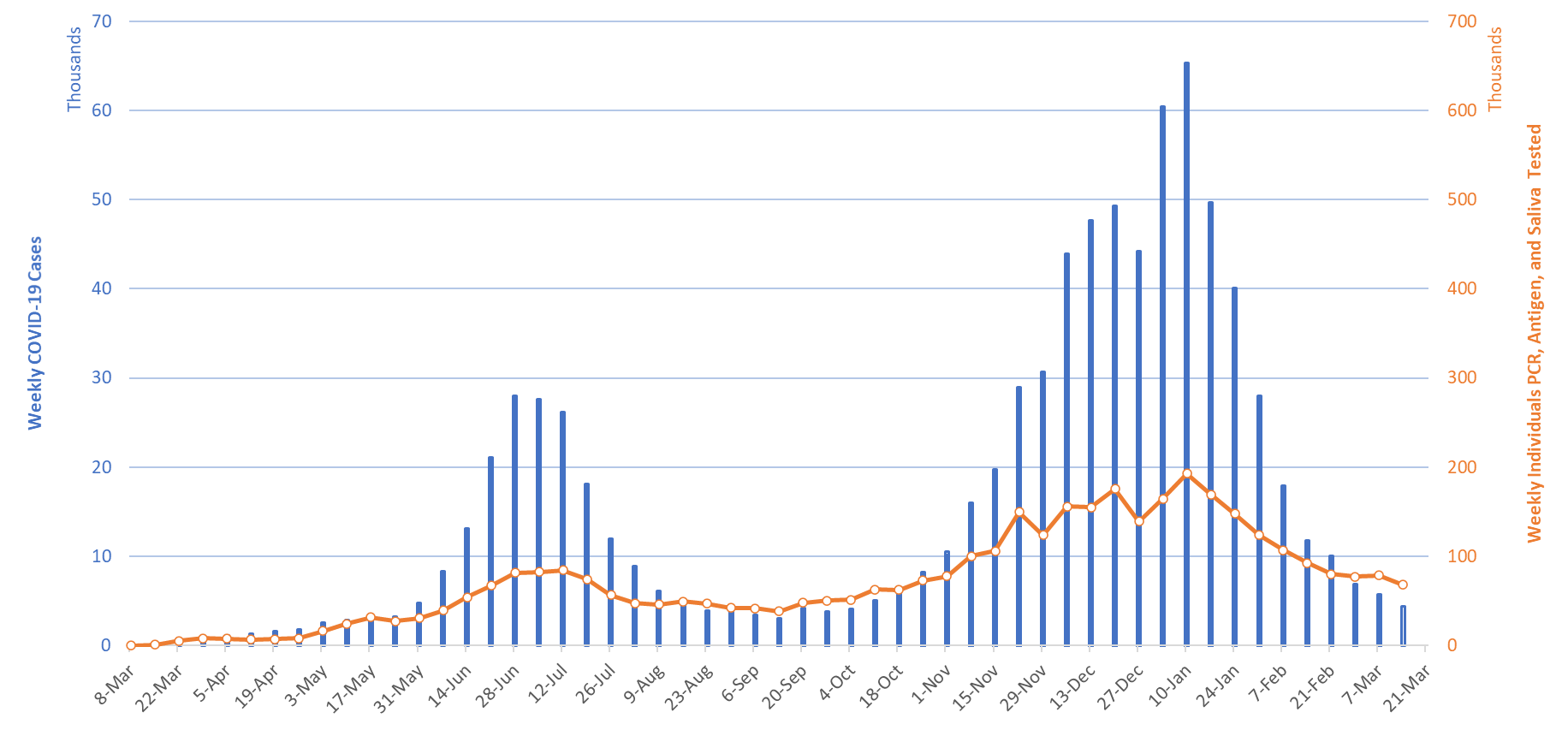
|
Figure 1. Newly Diagnosed Covid-19 Cases in Arizona and Number of Individuals Undergoing Covid-19 Diagnostic Testing March 1, 2020 through March 14, 2021. |
Arizona is beginning to transition from a period of substantial risk to one of moderate risk with continuing, albeit smaller, improvements in case counts expected over the coming weeks. Hospital capacity remains adequate to meet Arizona’s foreseeable needs; however, the backlog of non-Covid care has yet to be fully addressed as evidenced by unseasonably high hospital occupancy.
While residents and businesses should continue to follow public health mitigation recommendations, normalization of low-risk activities is reasonable as case rates have fallen below 100 new diagnoses per 100,000 residents per week. New cases are being diagnosed at a rate of 61 per 100K residents per week. For reference, September 8th marked the fall nadir between the summer and winter outbreaks at 38 per 100K per week. Arizonans who are at risk of developing severe disease (e.g., age or comorbid conditions) should remain sheltered as much as feasible until fully vaccinated.
Note: Data for this report was updated Friday, March 19 allowing 4 full days to adjudicate cases and keep week-over-week backfill 10%. This allows more interpretable comparisons and graphics. All comparisons are week-over-week changes. Future updates will be released on Saturdays.
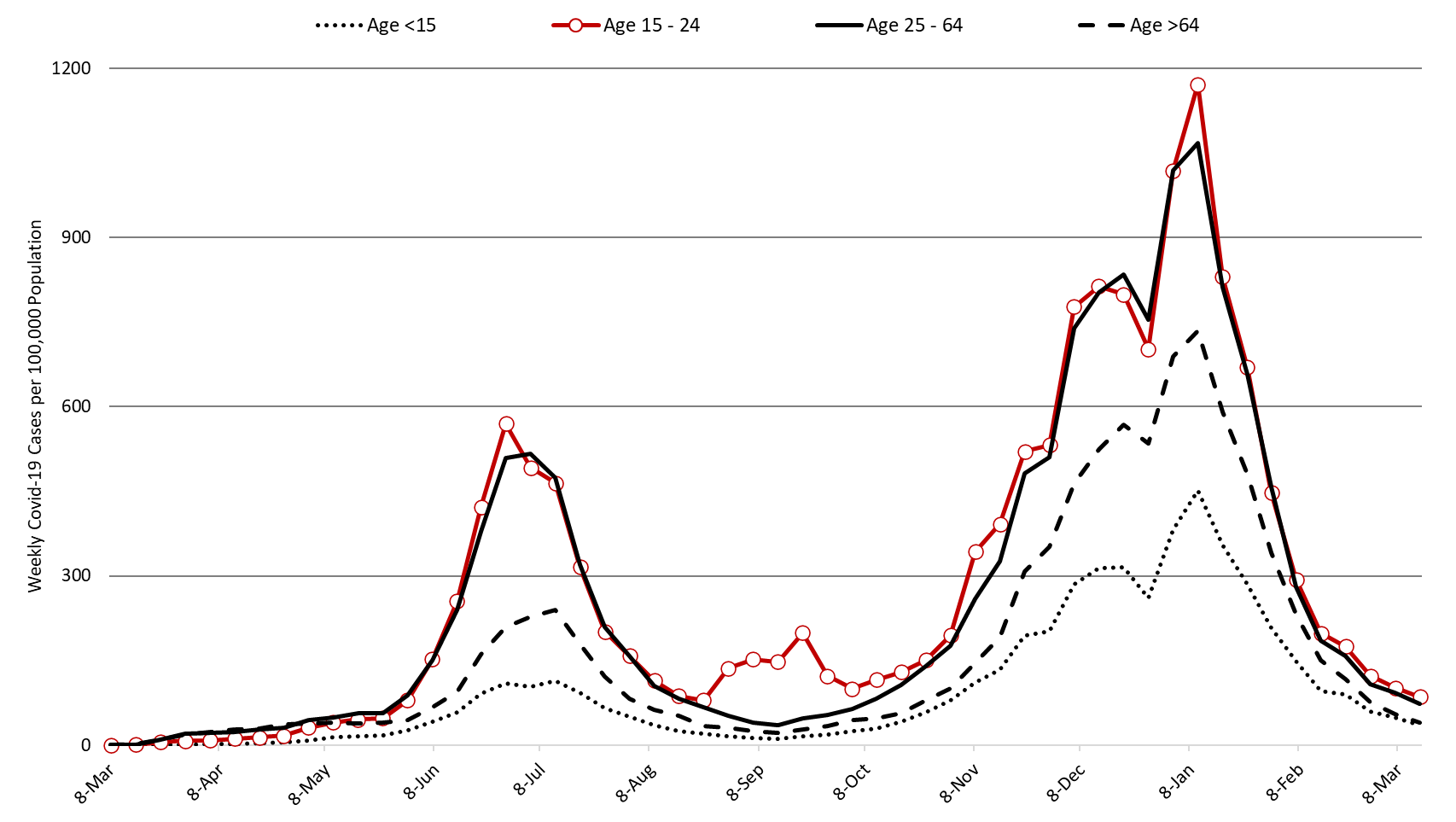
|
Figure 2. Newly Diagnosed Covid-19 Cases in Arizona by Age Group March 1, 2020 through March 14, 2021. |
Test positivity among those undergoing traditional nasopharyngeal PCR testing continues to decline, declining from 9% the week ending March 7th to 8% the week ending March 14th (Figure 3). Positivity is now within the recommended 5 – 10% for optimal public health practice.
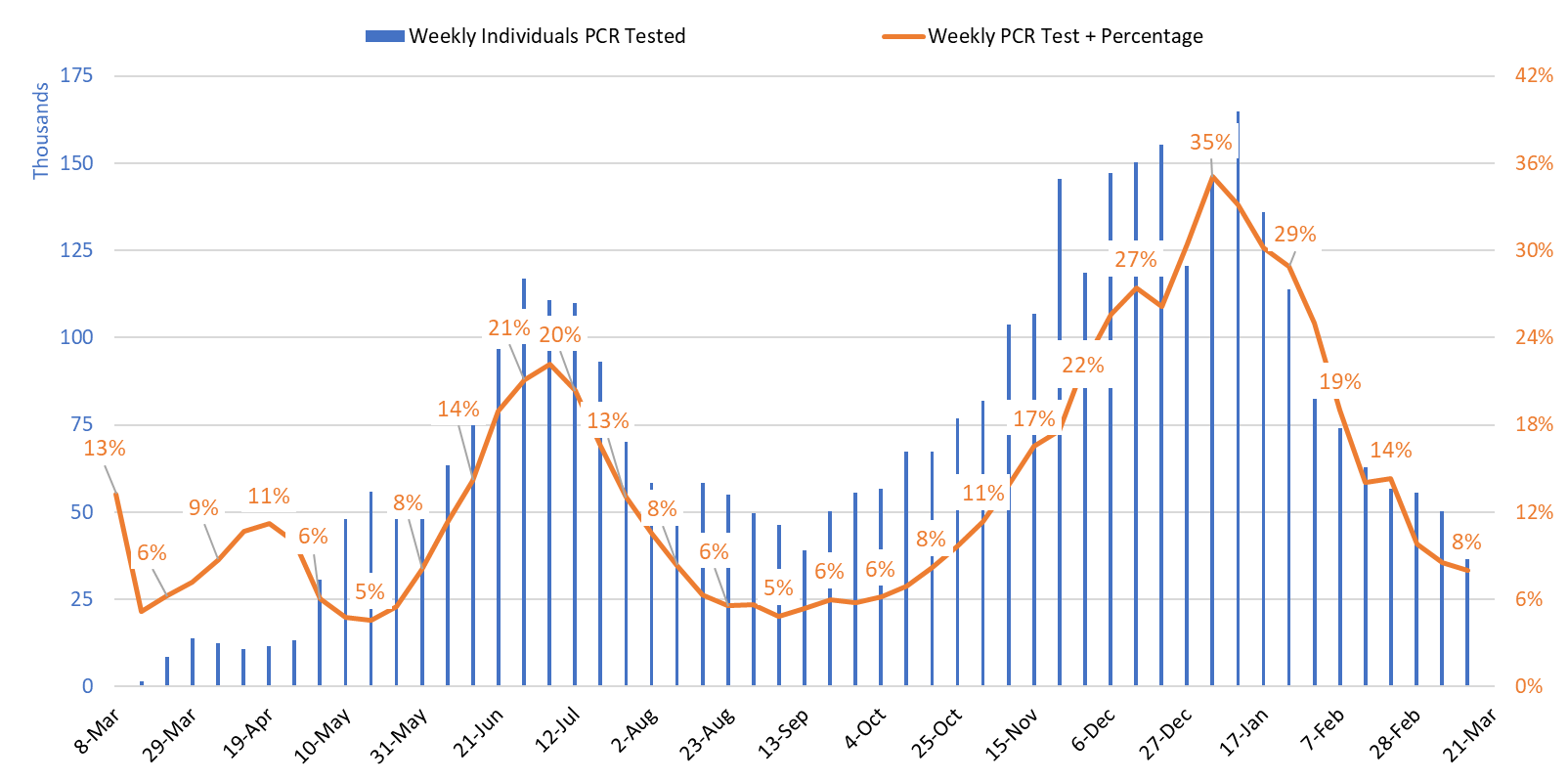
|
Figure 3. Weekly Number Patients Undergoing Traditional Nasopharyngeal PCR Testing and Associated Percent Positivity March 1, 2020 – March 14, 2021. |
As of March 19th, 700 (8%) of Arizona’s 8587 general ward beds were occupied by Covid-19 patients, a 14% decrease from the previous week’s 814 occupied beds (Figure 4 and Figure 5 Panel A). Another 978 (11%) beds remained available for use. The number of available beds is lower than the previous week’s 1011 beds.
Covid-19 occupancy has dropped by 86% from its January 11th peak of 5082 ward patients. Nevertheless, hospitals remain above seasonal occupancy.
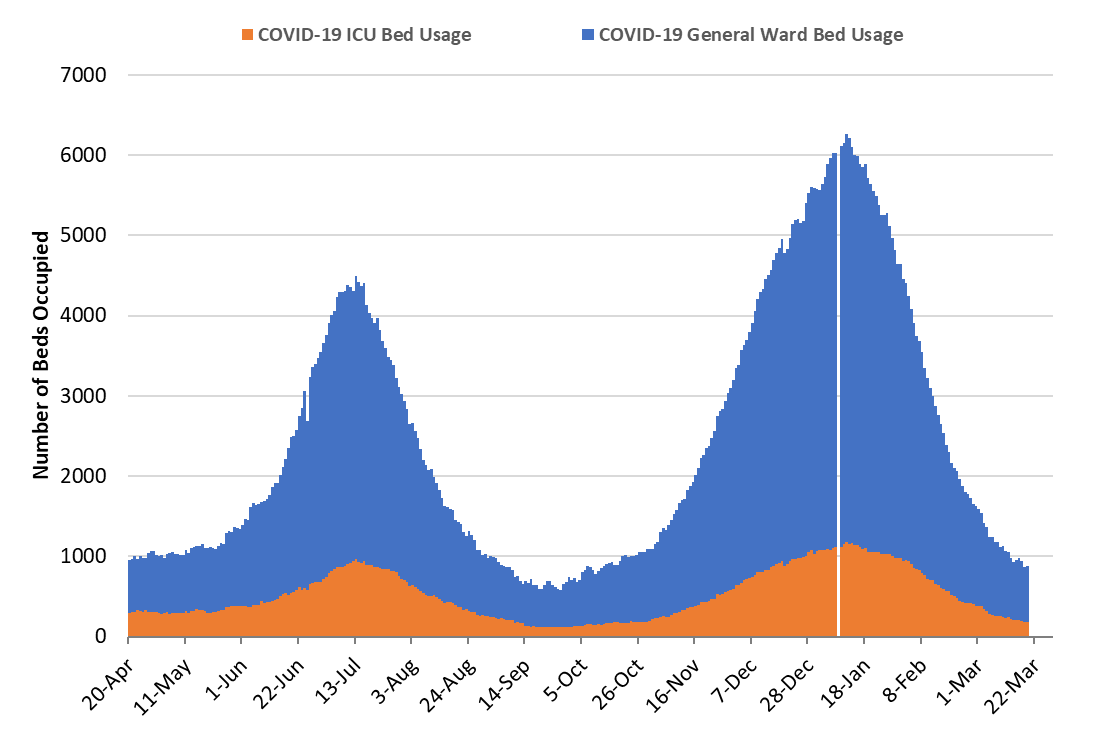
|
Figure 4. Arizona Daily Covid-19 General Ward and ICU Census April 20, 2020 – March 19, 2021. |
As of March 19th, 182 (11%) of Arizona’s 1734 ICU beds were occupied with Covid-19 patients, a 24% decrease from the prior week’s count of 238 patients (Figure 4 and Figure 5 Panel B). An additional 259 (15%) ICU beds remained available for use. This is similar to the prior week’s 262 available beds. ICU occupancy has fallen 85% from its January 11th peak of 1183 occupied beds.
|
Figure 5. Covid-19 Occupancy as a Percent of Listed General Ward (A, left) and ICU (B, right) Capacity in Arizona April 20, 2020 – March 19, 2021. |
While Arizona hospitals’ safety margins remain low, they are slowly improving (Figure 6). Medically necessary procedures are now being scheduled in a more typical manner. The backlog of postponed care will take several more months to resolve. As capacity constraints are lessened, care practices should return to those prior to the outbreak ensuring all patients will receive optimal care. Hospitals will remain crowded through early April before returning to pre-outbreak levels assuming continued reductions in viral transmission.
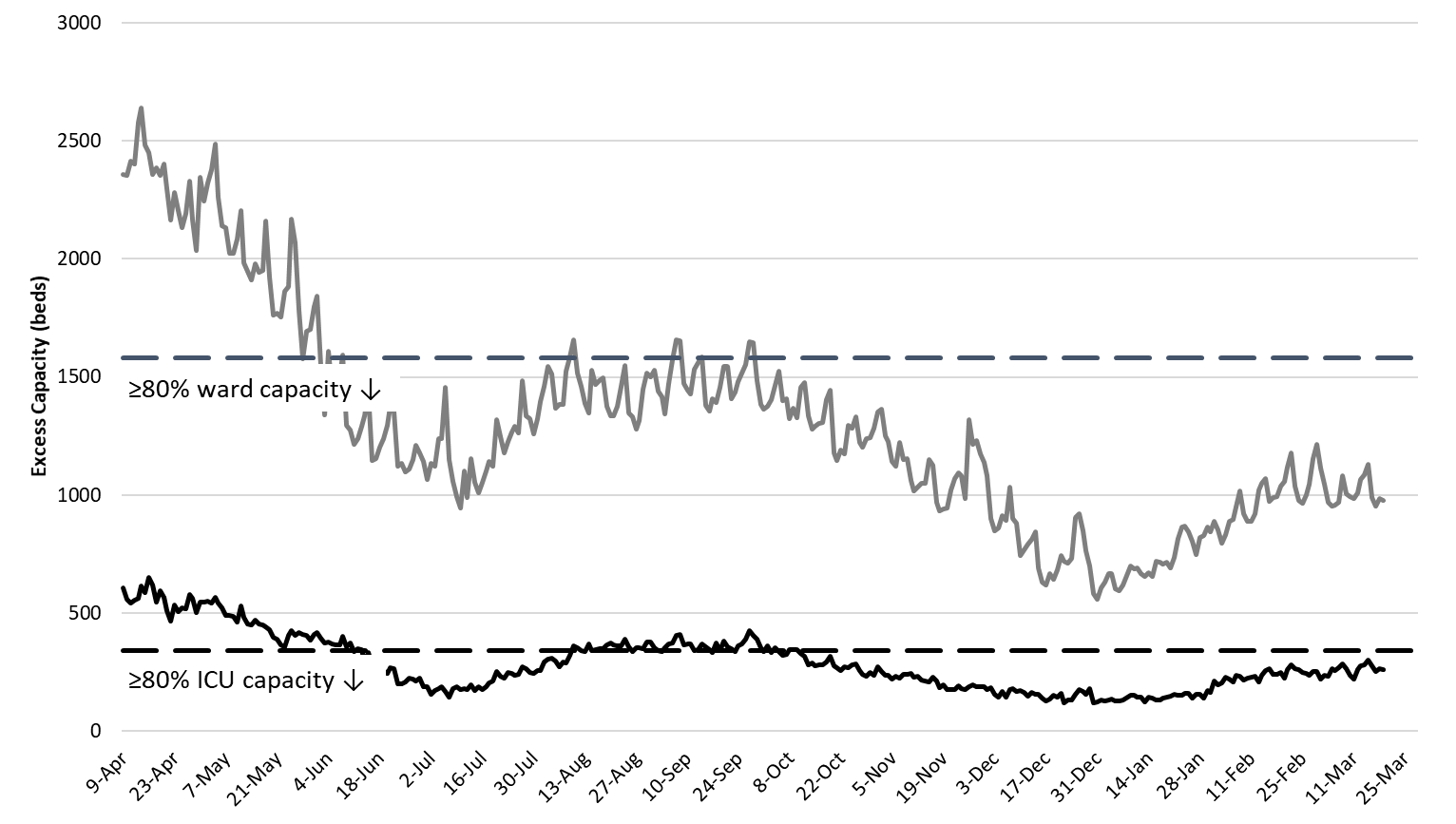
|
Figure 6. Observed Excess Non-Surge General Ward and ICU Capacity April 20, 2020 – March 19, 2021. |
The week ending January 17th remains Arizona’s deadliest with 1052 deaths (Figure 7). The week of January 17th represents peak mortality with subsequent improvements for the foreseeable future. Covid-19 deaths are expected to remain high for the next week or so, falling below 200 per week by the end of March.
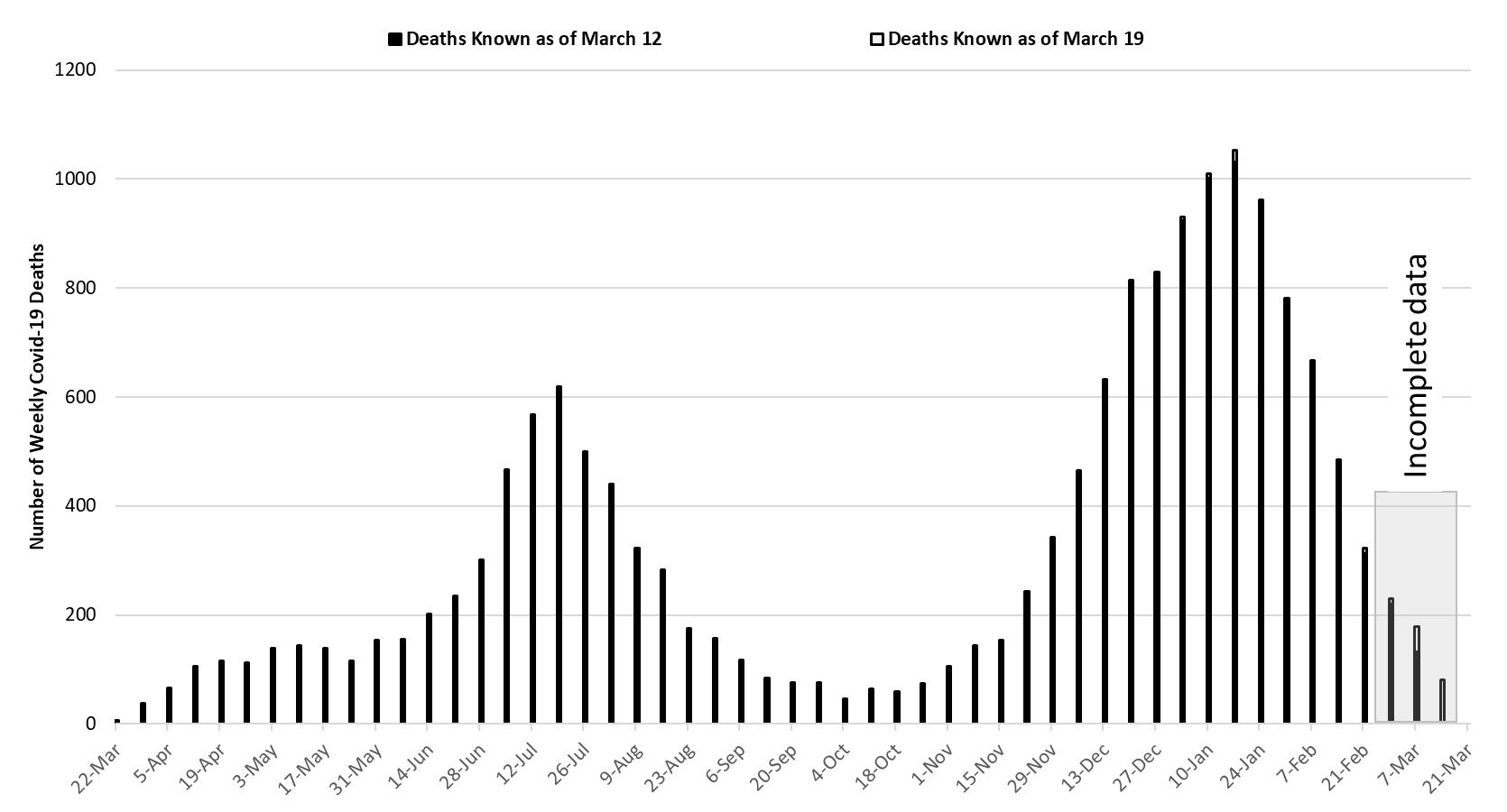
|
Figure 7. Weekly Arizona Covid-19 Deaths March 1, 2020 – March 14, 2021. |
Pima County Outlook
For the week ending March 14th, 548 Pima County residents were diagnosed with Covid-19, a 20% decrease from the 684 cases initially reported last week (Figure 8). Last week’s initial tally was upwardly revised by 1% (8 cases) to 692 cases.
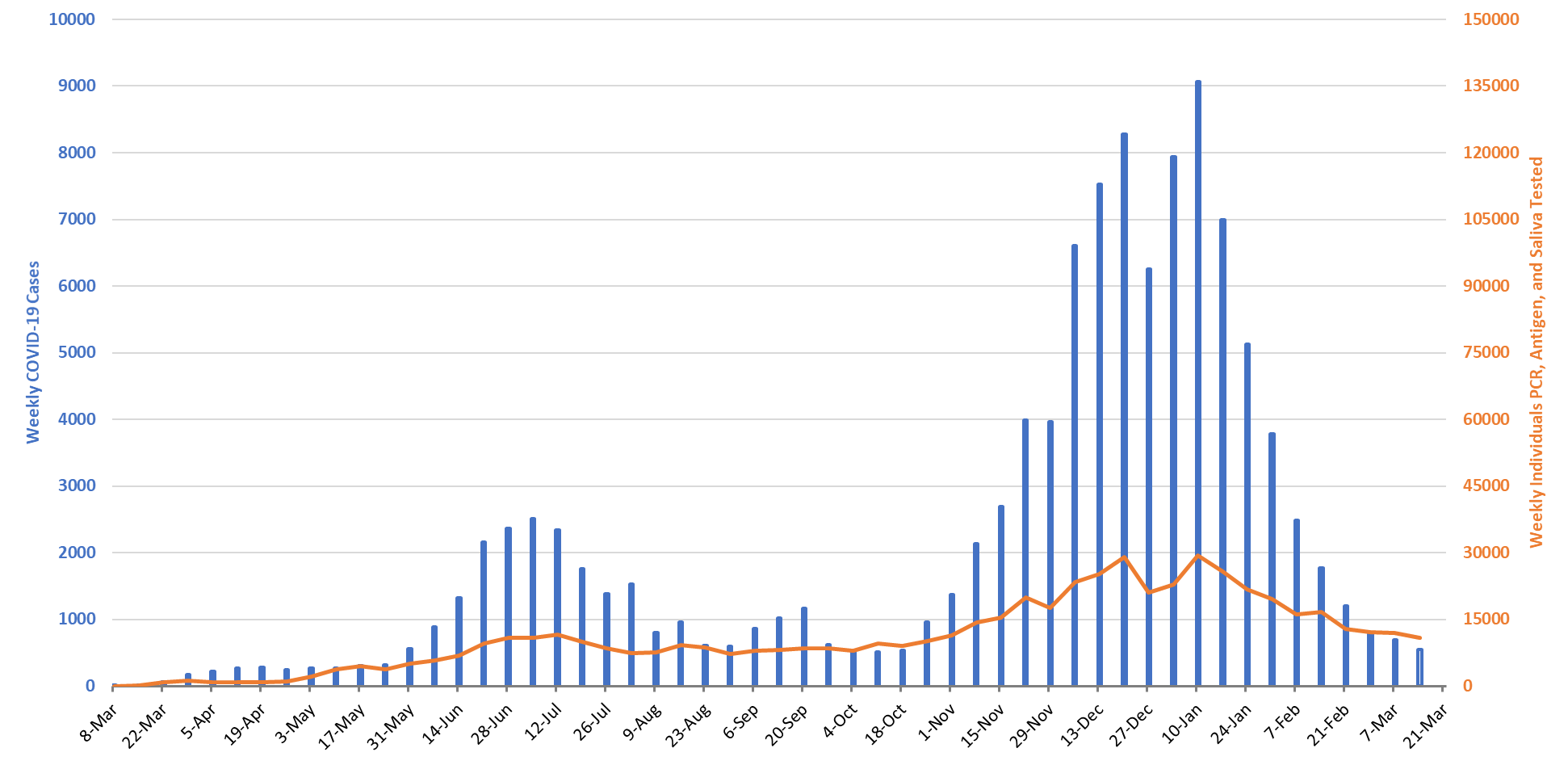
|
Figure 8. Covid-19 Cases and Individuals Undergoing Diagnostic Testing in Pima County March 1, 2020 – March 14, 2021 |
New cases are being diagnosed at a rate of 52 cases per 100K residents per week. For reference, October 9th marked a nadir between the summer and winter outbreak at 46 cases per 100K residents per week. Trends are similar across the various age groups (Figure 9).
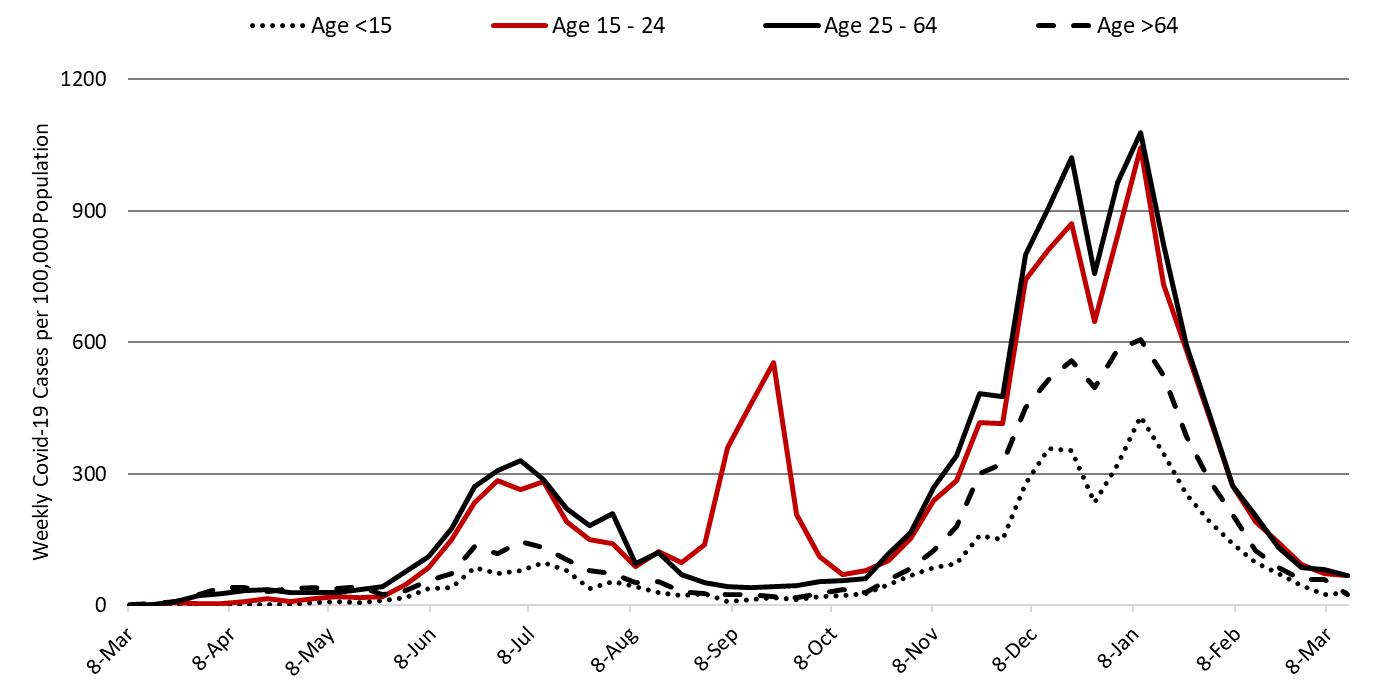
|
Figure 9. Covid-19 Cases by Age Group in Pima County from March 1, 2020 – March 14, 2021. |
Summary
- This week saw a ninth straight week of meaningful declines in Covid-19 cases and hospital occupancy. Absolute levels of SARS-CoV-2 viral transmission have fallen below the 100 new cases per 100,000 residents per week threshold in all Arizona counties.
- As of March 14th, new cases were being diagnosed at a rate of 61 cases per 100,000 residents per week (Figure 10 below). This rate is declining by 17 cases per 100,000 residents per week.
- While Arizona has one of the lowest viral transmission rates in the US according to the CDC, it remains the 6th hardest hit state overall.
- All residents should continue to wear a mask in public, avoid large social gatherings, maintain physical distance from non-household contacts, avoid >15 minutes contact in indoor spaces, especially if physical distancing is inadequate and adherence to face masks is low.
- While residents and businesses should continue to follow the recommended public health mitigation efforts, normalization of lower risk activities is reasonable throughout the state.
- The test positivity rate for traditional nasopharyngeal PCR testing is now 10% which is within the recommended 5 – 10% range for optimal public health practice.
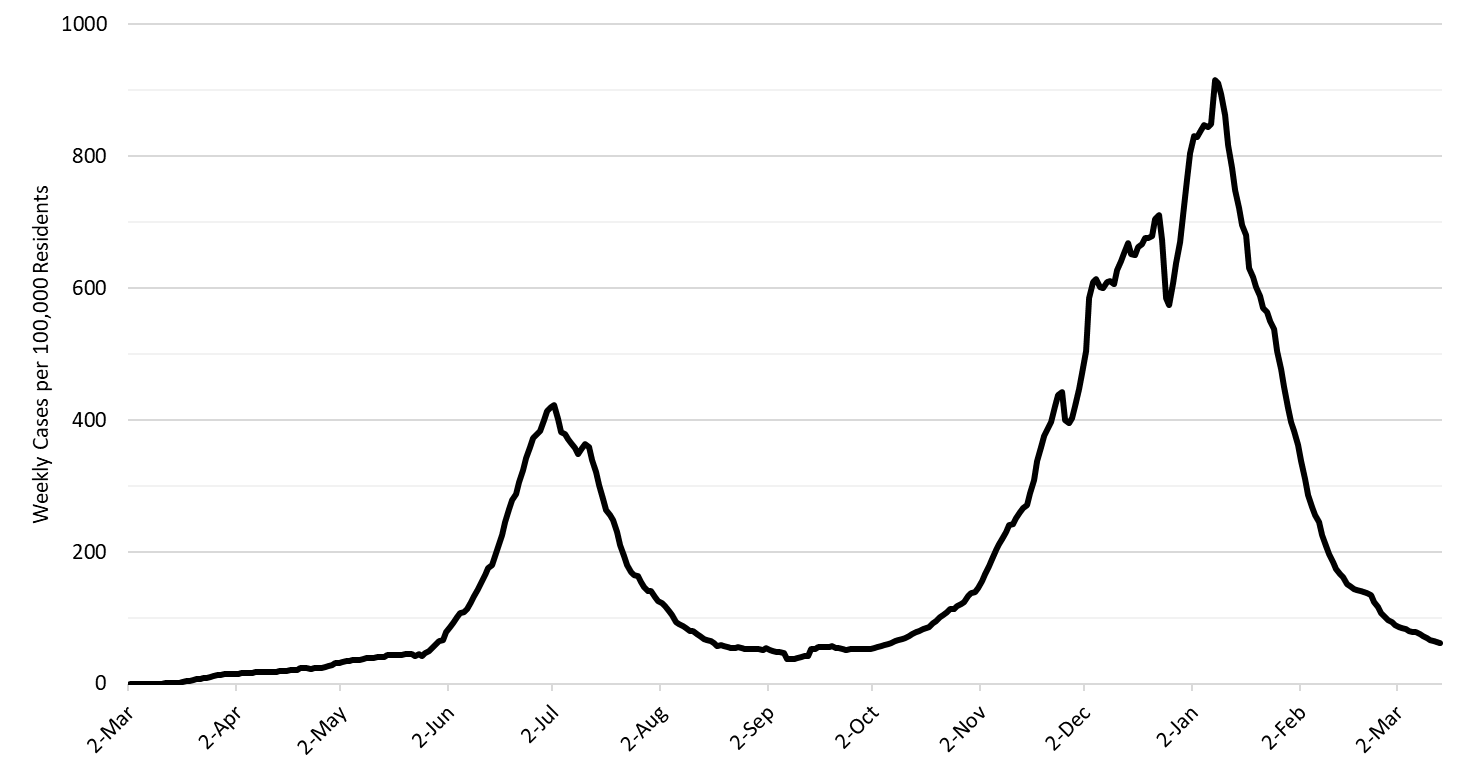
|
Figure 10. 7-Day Moving Average of Arizona Covid-19 Cases by Date of Test Collection Mar 1, 2020 – March 14, 2021. |
- In all communities, absolute levels of transmission and test positivity have reached levels that warrant a return to in-person instruction using a hybrid mode or reduced attendance (see CDC Recommended Mitigation Strategies for K – 12 Learning Modes). Full in-person instruction is not recommended by the CDC until transmission falls below 50 cases per 100K residents per week.
- Hospital Covid-19 occupancy continues to decline in the ward and ICU. Access to care however, remains somewhat restricted as the backlog of medically necessary non-Covid procedures is addressed.
- Arizona is still reporting a large number of weekly deaths and this count may underestimate true fatalities. The week ending January 17th will be Arizona’s deadliest with >1000 deaths. Arizona’s weekly tally of deaths ranks it 12th in the nation while its overall rank remains 6th since the outbreak began.
- According to the CDC, 17.4% of Arizona adults have received at least 2-doses of vaccine while another 13.0% have received 1-dose. The ADHS Dashboard is reporting slightly higher levels.
Forecast reports to date, available as PDFs
Download PDF to view additional charts of Arizona counties, available in appendix of report.
2020 Reports
Based on what we know now about this pandemic, we support guidelines for social distancing to slow the spread of the virus and urge everyone to follow the recommendations provided by the Centers for Disease Control and Prevention (CDC) to protect yourself, your family, your neighbors, and your employees. Please heed the recommendations as provided by the CDC, found at the following website: https://www.cdc.gov/coronavirus/2019-ncov/prepare/prevention.html
COVID covid coronavirus virus covid19 corona forecast model

